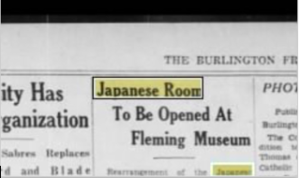Since the Museum Anthropology class has wrapped up, some of the Fleming’s interns have been going through boxes of old newspaper clippings from the late 1920s to the late 1950s. Our primary goal is to flag any instances of additional household artifacts and period rooms that have appeared or been exhibited by the Fleming—basically, we have been gathering intel so that the Fleming staff members have a more complete understanding of their museum’s past regarding the display of “home”.
The relevant research that we have come across includes artifacts such as miniature Japanese household utensils and outrageous feathered hats from the 1880s. Period rooms also held value throughout the Fleming’s history, and quite a few have focused on Early Americana with specific references to famous Vermonters. Some of these exhibits included Martin Chittenden’s desk and Ethan Allen’s china, as well as a copper kettle and a lowboy that was owned and used by the famous founder during his expeditions.

We have also been doing some background research on the donors of the artifacts that will be in the “House to Home” exhibit. Several of the donors are big names in Burlington—two of whom I just mentioned, as well as Katherine Wolcott, the niece of Robert Hull Fleming who funded the construction of the Fleming building in 1929, and Henry LeGrand Cannon, a Vermonter who traveled throughout East India and Java and brought his extensive collection to the Fleming. Once we obtain more information about the donors, we can continue to have important conversations about antiquarianism and pre-1970 collection techniques that fostered Eurocentric curiosity.
Many of these artifacts have been displayed since the 1930s in varying contexts, but the goal of the House to Home exhibition is not merely to showcase intriguing household items from famous people or faraway lands. It strives to investigate the notions of self, community, and the home through a presentation of artifacts that both highlight their unique cultural and utilitarian properties and connect them based on a cross-cultural foundation. Hopefully, visitors will form a connection with each of the objects in ways that align with and challenge their preconceived notions of what a home ‘should’ be.
